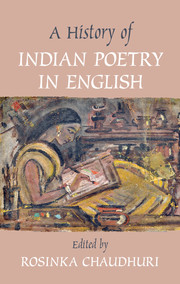Book contents
- Frontmatter
- Contents
- Contributors
- Acknowledgments
- Introduction
- SECTION I THE BROAD NINETEENTH CENTURY: INDIANS IN ENGLISH AND THE ENGLISH IN INDIA
- SECTION II PUBLISHERS, PUBLISHING HOUSES, AND THE PERIODICAL PRESS
- SECTION III POETRY: 1950–2000
- 13 Nissim Ezekiel: Poet of a Minor Literature
- 14 Dom Moraes: A Poet's Progress
- 15 Interpretative Testimony: Kamala Das and Eunice de Souza
- 16 Adil Jussawala and the Double Edge of Poetry
- 17 Arvind Krishna Mehrotra and the Interplay of Languages
- 18 Arun Kolatkar: A Singular Poetry in Two Languages
- 19 Imagery and Imagination in the Poetry of Jayanta Mahapatra
- 20 Modernisms and Modernity: Keki Daruwalla and Gieve Patel
- 21 The Third Generation: Melanie Silgardo and Manohar Shetty
- SECTION IV POETS OF THE DIASPORA
- SECTION V THE NEW MILLENNIUM POETS ON THEMSELVES
- Bibliography
- Index
14 - Dom Moraes: A Poet's Progress
from SECTION III - POETRY: 1950–2000
Published online by Cambridge University Press: 05 March 2016
- Frontmatter
- Contents
- Contributors
- Acknowledgments
- Introduction
- SECTION I THE BROAD NINETEENTH CENTURY: INDIANS IN ENGLISH AND THE ENGLISH IN INDIA
- SECTION II PUBLISHERS, PUBLISHING HOUSES, AND THE PERIODICAL PRESS
- SECTION III POETRY: 1950–2000
- 13 Nissim Ezekiel: Poet of a Minor Literature
- 14 Dom Moraes: A Poet's Progress
- 15 Interpretative Testimony: Kamala Das and Eunice de Souza
- 16 Adil Jussawala and the Double Edge of Poetry
- 17 Arvind Krishna Mehrotra and the Interplay of Languages
- 18 Arun Kolatkar: A Singular Poetry in Two Languages
- 19 Imagery and Imagination in the Poetry of Jayanta Mahapatra
- 20 Modernisms and Modernity: Keki Daruwalla and Gieve Patel
- 21 The Third Generation: Melanie Silgardo and Manohar Shetty
- SECTION IV POETS OF THE DIASPORA
- SECTION V THE NEW MILLENNIUM POETS ON THEMSELVES
- Bibliography
- Index
Summary
Against Facility
In 1957, a small London imprint called The Parton Press published a first book by an Indian poet who had just turned nineteen. The press's unlikely proprietor was David Archer, a Soho habitué whose literary bookshop on Parton Street had become a meeting place for the British Modernists of the thirties. Editors and writers met there, and innovative literary projects came to life on the premises, including the incendiary left-wing journal Contemporary Poetry and Prose. More importantly, Archer published three of the decade's best poets, each destined for early fame: Dylan Thomas, George Barker, and the mercurial surrealist David Gascoyne, whose descent into amphetamine psychosis and institutional care was still some years away. Archer published Graham Greene's first novel, and he also published W. S. Graham, yet there has been no scholarly study of his contribution to British letters. This may have had everything to do with his personality. Even the carefully eccentric – in the quaint British sense of the word – citizens of Soho thought him strange. He liked to claim that he read only detective thrillers. He did not actually read the poets and writers he published; he went, he said, by smell. If his taste in poets was infallible, his accounting practices were less so. He used most of the inheritance his father had left him to rent the premises for his bookshops. Sometimes he would refuse to accept money from customers, and often he would empty the till to help an impoverished or thirsty friend. He had an unusual way of paying the poets he published: a five-pound note folded into a matchbox. Archer shut down the Parton Street bookshop during the war and reopened it in the late fifties on Greek Street in the heart of Soho. This is the establishment he is remembered for, if he is remembered at all. It was so radical an experiment in bookselling, and book-keeping, that it held the attention of an exuberant post-war generation of writers and readers.
- Type
- Chapter
- Information
- A History of Indian Poetry in English , pp. 223 - 234Publisher: Cambridge University PressPrint publication year: 2016
- 1
- Cited by



